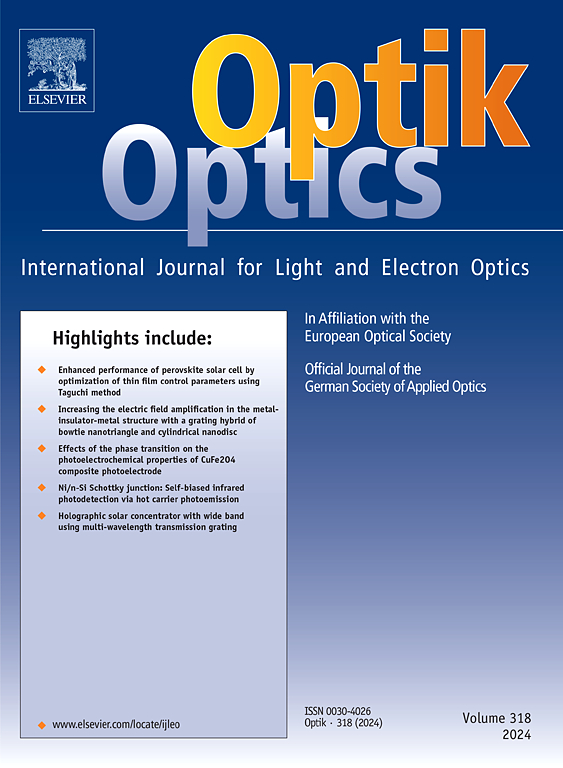CdTe、CdS和核壳CdTe/CdS量子点纳米粒子非线性光学性质的激光波长依赖性
IF 3.1
3区 物理与天体物理
Q2 Engineering
引用次数: 0
摘要
本文采用光化学方法合成了CdTe、CdS和CdTe/CdS核壳纳米粒子,并利用x射线衍射光谱(XRD)、扫描电子显微镜(SEM)、紫外可见吸收光谱(UV-Vis)和光致发光光谱(PL)等技术对其结构和光学性能进行了表征。结果表明,合成的CdTe、CdS和CdTe/CdS纳米粒子的光带隙分别为2.32、2.37和2.15 eV,平均尺寸分别为3、2.8和8 nm。分别具有均匀的尺寸和分布,除此之外,它们的光学性质高度依赖于它们的尺寸和化学成分。随后,利用z扫描技术,在波长和脉宽分别为1064 nm和3 ns的连续波二极管(532 nm)、He-Ne(632.8 nm)和Nd:YAG脉冲激光(532 nm)及其二次谐波(SHG)下,对纳米粒子的非线性吸收(NLA)和非线性折射(NLR)系数进行了评估。实验结果表明,CdTe、CdS和CdTe/CdS纳米粒子表现出独特的NLA和NLR行为,并且由于对激光波长的强烈依赖而达到光学极限。对于532 nm二极管激光器(CdTe、CdS和CdTe/CdS)量子点,计算得到NLA和NLR系数和阶数分别为(53.48、27.94、30.13)cm/MW和(6.496、-14.206、9.21)cm2/GW。结果表明,连续波二极管激光器(532 nm)具有单光子吸收(SPA)机制,632.8 nm具有双光子吸收(TPA)机制,1064 nm具有反饱和吸收(RSA)机制,并且(NLR)在每个纳米粒子上都观察并确定了自聚焦和离焦机制。这些发现可以作为设计和开发利用这些纳米粒子的先进光子和光学器件的基础。本文章由计算机程序翻译,如有差异,请以英文原文为准。
Laser Wavelength dependence of nonlinear optical properties of CdTe, CdS, and core-shell CdTe/CdS QD nanoparticles
In this paper, CdTe, CdS, and CdTe/CdS core-shell nanoparticles were synthesized using photochemical methods, and their structural and optical properties were examined using techniques such as X-ray diffraction spectroscopy (XRD), Scanning Electron Microscopy (SEM), UV-Vis absorption and Photoluminescence (PL) spectroscopy. The results showed that the synthesized nanoparticles CdTe, CdS, and CdTe/CdS with optical bandgaps of 2.32, 2.37, and 2.15 eV, and 3, 2.8, and 8 nm average sizes. respectively have uniform sizes and distributions, beyond that their optical properties are highly dependent on their size and chemical composition. Afterward, using the Z-scan technique, nanoparticles nonlinear absorption (NLA) and nonlinear refraction (NLR) coefficients were evaluated under CW laser Diode (532 nm), He-Ne (632.8 nm), and Nd:YAG pulsed laser with wavelength and pulse width (1064 nm, 3 ns) and its second harmonic (SHG) (532 nm). According to the experimental results, CdTe, CdS, and CdTe/CdS nanoparticles have shown unique NLA and NLR behaviors and strike optical limiting due to strong dependency on laser wavelengths. For 532 nm diode laser (CdTe, CdS, and CdTe/CdS) QDs, the NLA and NLR coefficients and orders were calculated as (53.48, 27.94, 30.13) cm/MW and (6.496, -14.206, 9.21) cm2/GW, respectively. The results indicate that (NLA) β with single photon absorption (SPA) mechanism for CW diode laser (532 nm), two-photon absorption (TPA) for 632.8 nm, and reverse saturable absorption (RSA) for 1064 nm IR/SHG lasers, and in the case of (NLR), the self-focusing and defocusing mechanisms have been observed and determined for each nanoparticle. These findings can serve as a basis for designing and developing advanced Photonic and optical and devices that utilize these nanoparticles.
求助全文
通过发布文献求助,成功后即可免费获取论文全文。
去求助
来源期刊

Optik
物理-光学
CiteScore
6.90
自引率
12.90%
发文量
1471
审稿时长
46 days
期刊介绍:
Optik publishes articles on all subjects related to light and electron optics and offers a survey on the state of research and technical development within the following fields:
Optics:
-Optics design, geometrical and beam optics, wave optics-
Optical and micro-optical components, diffractive optics, devices and systems-
Photoelectric and optoelectronic devices-
Optical properties of materials, nonlinear optics, wave propagation and transmission in homogeneous and inhomogeneous materials-
Information optics, image formation and processing, holographic techniques, microscopes and spectrometer techniques, and image analysis-
Optical testing and measuring techniques-
Optical communication and computing-
Physiological optics-
As well as other related topics.
 求助内容:
求助内容: 应助结果提醒方式:
应助结果提醒方式:


